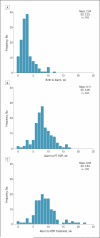Importance of early postnatal weight gain for normal retinal angiogenesis in very preterm infants: a multicenter study analyzing weight velocity deviations for the prediction of retinopathy of prematurity
- PMID: 22491391
- PMCID: PMC4059056
- DOI: 10.1001/archophthalmol.2012.243
Importance of early postnatal weight gain for normal retinal angiogenesis in very preterm infants: a multicenter study analyzing weight velocity deviations for the prediction of retinopathy of prematurity
Abstract
Objective: To assess WINROP (https://winrop.com), an algorithm using postnatal weight measurements, as a tool for the prediction of retinopathy of prematurity (ROP) in a large geographically and racially diverse study population.
Methods: WINROP analysis was performed retrospectively on conventionally at-risk infants from 10 neonatal intensive careunits.Weight measurements were entered into WINROP, which signals an alarm for an abnormal weight gain rate. Infants were classified into categories of no alarm (unlikely to develop type 1ROP)and alarm (at risk for developing type 1ROP).Use of WINROP requires that an infant has (1) gestational age less than 32 weeks at birth, (2) weekly weight measurements,(3) physiologic weight gain,and(4)absence of other pathologic retinal vascular disease.
Results: A total of 1706 infants with a median gestational age of 28 weeks (range, 22-31 weeks) and median birth weight of 1016 g (range, 378-2240 g) were included in the study analysis. An alarm occurred in 1101 infants (64.5%), with a median time from birth to alarm of 3 weeks (range, 0-12 weeks) and from alarm to treatment of 8 weeks (range, 1 day to 22 weeks). The sensitivity of WINROP was 98.6% and the negative predictive value was 99.7%. Two infants with type 1 ROP requiring treatment after 40 weeks' postmenstrual age did not receive an alarm.
Conclusion: The WINROP system is a useful adjunct for ROP screening that identifies high-risk infants early to optimize care and potentially reduce the overall number of diagnostic ROP examinations.
Figures



References
-
- Gilbert C, Fielder A, Gordillo L, et al. International NO-ROP Group. Characteristics of infants with severe retinopathy of prematurity in countries with low, moderate, and high levels of development: implications for screening programs. Pediatrics. 2005;115(5):e518–e525. - PubMed
-
- Maida JM, Mathers K, Alley CL. Pediatric ophthalmology in the developing world. Curr Opin Ophthalmol. 2008;19(5):403–408. - PubMed
-
- Section on Ophthalmology American Academy of Pediatrics; American Academy of Ophthalmology; American Association for Pediatric Ophthalmology and Strabismus Screening examination of premature infants for retinopathy of prematurity. Pediatrics. 2006;117(2):572–576. - PubMed
Publication types
MeSH terms
Grants and funding
LinkOut - more resources
Full Text Sources
Other Literature Sources
Medical

